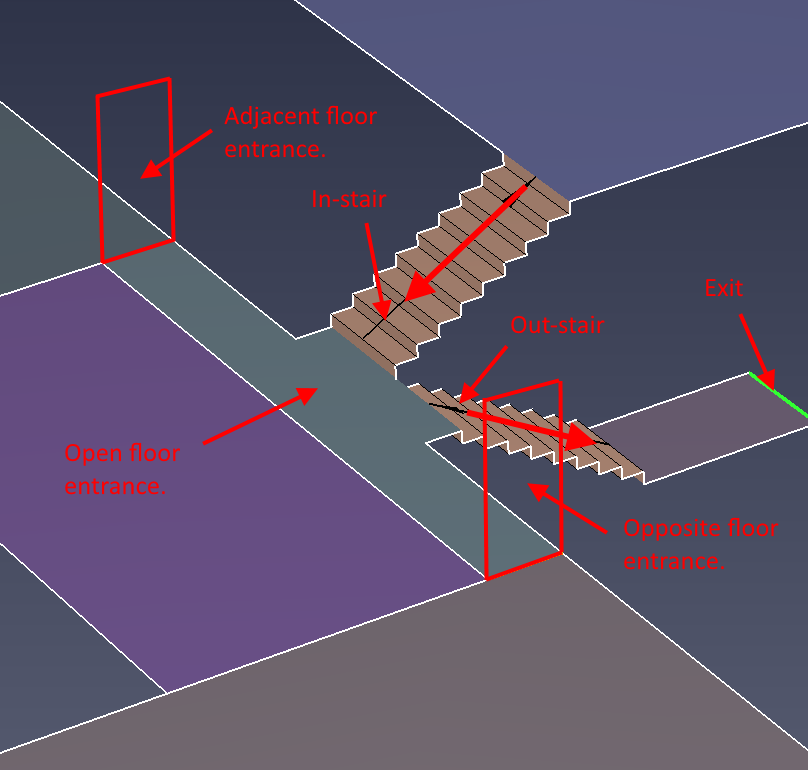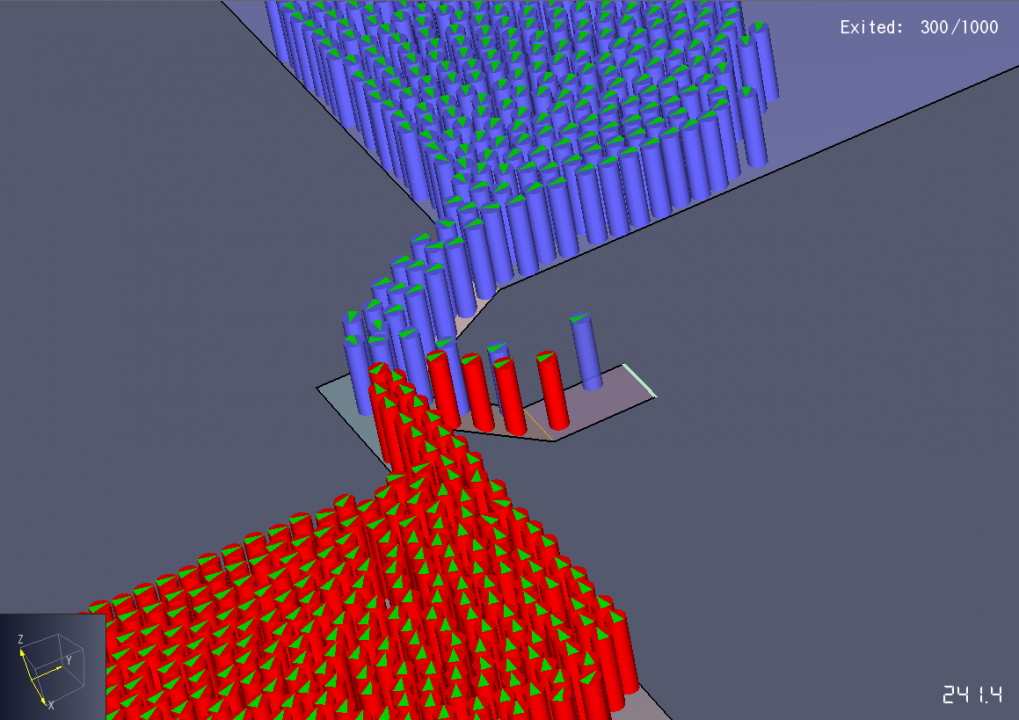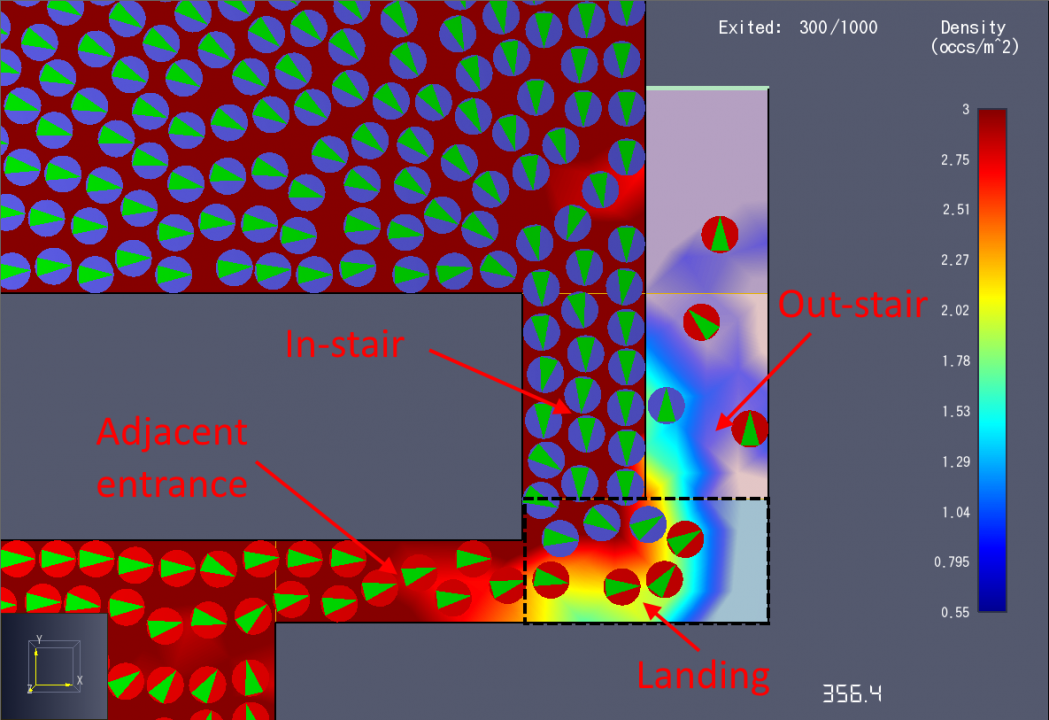Merging Behavior on Stairs
During evacuation using stairs, the geometry of the stairs and landings can change the merging behavior. On the landing, the occupants entering from the floor must merge with the occupants already on the incoming stairs. This post discusses Pathfinder simulations of these effects.
Two useful resources that discuss merging behavior on a staircase are papers by Galea, et al.(2008) and Boyce, et al.(2012). The Galea paper discusses the effect of floor-stair geometry on merging. The authors present a difference in merging behavior depending on whether the floor entrance to the landing is Adjacent or Opposite to the incoming stair (see figure below). In summarizing the data, the authors report that for adjacent floor-stair geometry "the merging process appears to be biased in favor of the floor population," with flow from the floor ranging from 60% (experimental) to 75% (simulation), corresponding to stair/floor ratios of 0.66 to 0.33. For opposite floor-stair geometry the Galea paper does not discuss experimental results, but simulations predicted the flow to be more evenly distributed with the floor flow ranging from 48% to 56%, corresponding to stair/floor ratios of approximately 1.1 to 0.78.

Boyce et al. describe three evacuation studies that focused on merging behavior in staircases and provide data for the Opposite floor-stair interface geometry that was not available at the time of the Galea paper. The authors report that "In evacuation study 1 the merging ratio over the whole period was almost 50:50, but varied somewhat throughout the merge period."
In our Pathfinder simulations, we use the Galea geometry (similar results have been obtained using the Boyce geometry) of a landing 1.5 m wide and 3.0 m long. The incoming/outgoing stairs have widths of 1.5 m with a rise/run of approximately 7/11 (total rise 1.6 m and total run 2.5 m). The corridors to the landing are 1.0 m wide. 500 people were placed on the the upper and floor levels for a total of 1000 people. Default Pathfinder parameters were used, except that the walking speeds were give a uniform range from 1.0 to 1.5 m/s (following Galea). We added a Open floor case, where the floor has direct access to both stairs.
Below, we present images showing the results at the time when 300 persons had exited.



The results are summarized in the table below.

For the merging ratios (stair flow/floor flow) we see:
- The adjacent geometry favors the floor.
- The opposite geometry has approximately equal flow rates/.
- The open geometry strongly favors the floor.
This adjacent and opposite results correspond to the discussions by Galea, et al. and Boyce, et al. I am not aware of experiments with open geometry.
The table also gives the total predicted exit times. In the Galea paper all flow rates down the out-stair are "full capacity" of 0.99 p/m-s (it is not clear whether a boundary layer was used in the simulation to calculate total flow). For a 1.5 m stair with a 7/11 rise/run, the SFPE specific flow rate is 1.015 p/m-s and the SFPE boundary layer is 0.15 m, giving a flow of 1.22 p/s. For corridors, the SFPE specific flow is 1.316 p/m-s and the SFPE boundary layer is 0.2 m, giving flows of 0.79 p/s for a 1 m width and 1.447 p/s for a 1.5 m width. For 1000 people to exit, the times are 819 s for the stair, 1265 s for the 1 m corridor, and 691 s for the 1.5 m corridor.
For the opposite geometry, the out-stair runs at essentially full capacity and results in an exit time of 816 s, nearly identical to the SFPE calculation. However, the results for both the adjacent and open geometries show longer exit times. For these cases, the stair is not used at full capacity. In Pathfinder 2015, the walking speed is a function of density. The density contours of the landing for the two cases are shown below.


For the adjacent geometry, the flows from the floor and in-stair must merge on the landing before reaching the stairs. This leads to a reduced speed in reaching the stairs and a longer exit time. For the opposite geometry, the flows from the flow and in-stair do not have the same conflict. Both flows can enter the out-stairs without first merging.
Summary
These simulations have confirmed a dependence on the landing geometry. In Pathfinder, the merging behavior is not specified directly, but is an emergent behavior that results from the individual decisions of occupants on the stairs and floor. For an Adjacent entrance, the flow from the floor is favored. For an Opposite entrance, the in-stairs and floor flows are approximately equal. These differences have been confirmed by experimental data.
For the opposite entrance case, the flow was limited by the capacity of the out-stair and this controlled the total exit time. However, in the adjacent entrance case, the flow was reduced due to high density developing on the landing where the in-stair and floor flows merged. This resulted in longer total exit times. To my knowledge, this has not been confirmed by experiment.
Update
Since this post was published, Pathfinder has been updated several times. This problem has been added to the Behavior Tests chapter, Corridor Merging section in the Pathfinder Verification and Validation manual. Please refer to this for the latest results.
References
Karen E. Boyce, David A. Purser and T. Jim Shields, 2012, "Experimental studies to investigate merging behaviour in a staircase," Fire and Materials, Special Issue: Special Issue on Human Behaviour in Fire, Volume 36, Issue 5-6, pages 383-398, August-October 2012. Published online in Wiley Online Library (wileyonlinelibrary.com). DOI: 10.1002/fam.1091.
E. R. Galea, G. Sharp, and P. J. Lawrence, 2008, "Investigating the Representation of Merging Behavior at the Floor-Stair Interface in Computer Simulations of Multi-Floor Building Evacuations," Journal of FIRE PROTECTION ENGINEERING, Vol. 18-November 2008.
Comments or Questions
This post was written by Daniel Swenson. For comments or questions, send email to support@thunderheadeng.com.